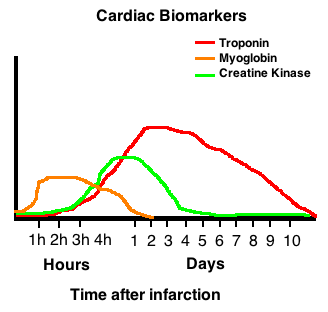General Cardiology Part 1
Cardiac enzymes (a.k.a. cardiac biomarkers) include myoglobin, troponin and creatine kinase. Historically, LDH (lactate dehydrogenase) was used as well; however, it is non-specific. Cardiac enzymes are released into the circulation when myocardial necrosis occurs as seen in myocardial infarction.
Myoglobin: Myoglobin is released into circulation with any damage to muscle tissue, including myocardial necrosis. Since skeletal muscle contains myoglobin, this measurement in quite non-specific for myocardial infarctions. The benefit lies in the fact that a detectable increase is seen only 30 minutes after injury occurs, unlike troponin and creatine kinase, which can take 3-4 hours.
Troponin: The enzymes troponin I and troponin T are normal proteins important in the contractile apparatus of the cardiac myocyte. They are released into the circulation about 3-4 hours after myocardial infarction, and are still detectable for 10 days afterward. The long half-life allows for the late diagnosis of myocardial infarction; however, that makes it difficult to detect re-infarction as can occur in acute stent thrombosis after percutaneous coronary intervention. There are a number causes of troponin elevation not related to myocardial infarction, however troponin elevation is much more sensitive than myoglobin and even CK.
Creatine kinase (CK): Creatine kinase (a.k.a. creatine phosphokinase or CPK) is a muscle enzyme which exists as isoenzymes. The MB type is specific to myocardial cells, while MM and BB are specific to skeletal muscle and brain tissue, respectively. The CK level will increase approximately 3-4 hours after a myocardial infarction and stays elevated for 3-4 days. This makes it useful for the detection of re-infarction in the 4-10 day time window after the initial insult, since troponin remains elevated for 10 days, making it less useful for this purpose.

